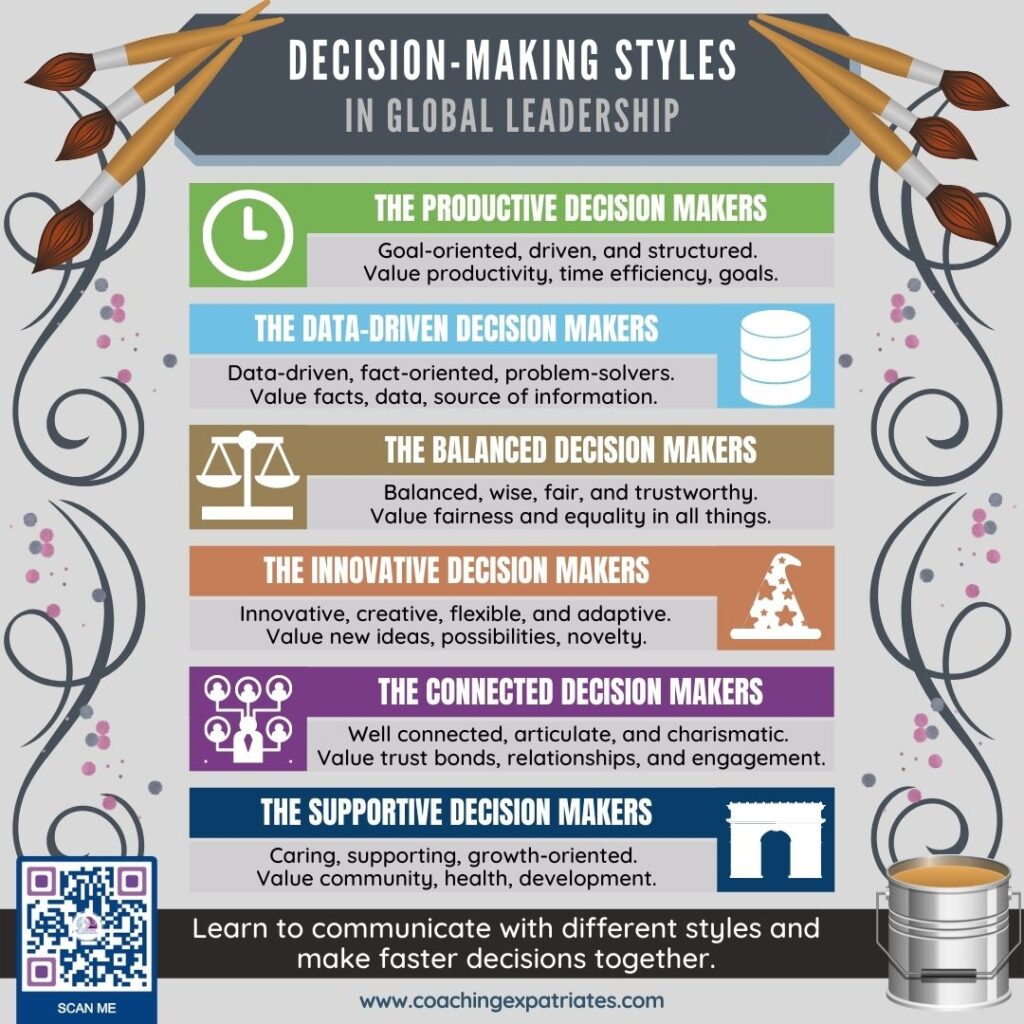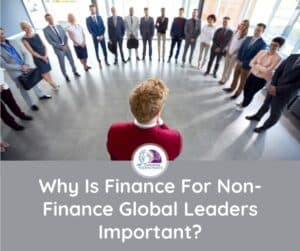What if I told you that if you learned how to deal with the different global leadership decision-making styles, you’d have a better chance of making faster decisions and succeeding faster in your career? Would you be interested in learning more about the global leadership decision-making styles?
Of course you would! Plus, it’s a fun topic!
Let’s jump right in!

Table of Contents
Executive Summary
Are you in a rush and want to watch a video instead? You can use the video below, and favorite the page to read later!
Different People, Different Styles
At the beginning of my career, I thought that all people wanted the same things, strived to achieve similar goals, and did that in similar ways. Yep, that’s right. I was pretty naïve. Global Leadership Decision-Making Styles was light-years ahead of my knowledge, back then. I had no idea it existed.
One day, I had a big discussion with a co-worker who wanted to leave at 5 pm, on a day that we had a project due and still many hours ahead of us. That day, I learned that people want different things. I – someone who always had the productive global leader style – worked overnight, alone, to get everything done in time. Nobody ever knew how hard this was for me, how hard I had to work that day. I also never managed to explain or voice it. I thought it was a waste of time, anyway.

The following year, someone else was in charge of the same project. The same thing happened. That co-worker went home at 5 pm, and the project was not yet done. That year’s leader had a different style altogether; he called a couple of his friends from another department to help us. He called a pizza in, and we spent hours into the night working, laughing, and having a good time.
We did not finish the project on time, though, and were scolded for not completing it in time. He, as the leader, had a negative bonus impact that year, because of that. But what’s interesting is that the boss finally took notice that the deadlines were too stretch for this project, and the timeline had to be restrategized.
Not only do different people have different leadership styles, but they also create different consequences based on what they focus on and how they decide things.
Although it might be obvious, I learned that it is always important to state the obvious to fully convey a message well: no one style is better than the other, but some types are more fitting in certain circumstances than others. Your job in global leadership is to learn about the styles and practice how to best apply them in each circumstance.
What Are The Global Leadership Decision-Making Styles, And Why Do They Matter?
There are many theories around styles: personality styles, leadership styles, team role styles, etc. These theories shed a different light in terms of what people focus on and what their preferences are.
‘Global Leadership Decision-Making Styles’ is a theoretical model that describes leader’s characteristics, behaviors, and preferences when coaching, leading, motivating, guiding, and managing their international teams during a decision-making process.
Different models approach the matter in different ways. The model we are using here at Coaching Expatriates® is based on values drivers. Each style has preferences that are based on a specific set of personal values. Things that are important to them and that they use as filters when making decisions.
Our purpose is not to put people into “boxes” or label them. The entire reason why these models exist is to help people make sense out of things in a more didactical way.
Let’s expand on this a little more: you or I am not purely one style or the other. In any of the major Personality styles – like Meyers Briggs or DiSC – or Leadership Styles like Goleman’s or 4 Styles. We can be closer to each model’s styles, but the models do not define us.

Each of us is pretty unique. We are a miracle of existence, and nothing simple like a theoretical model can define us with precision. However, these models can help us raise awareness about people’s preferences and values. They create greater understanding among people.
This knowledge helps people relate better to us and helps us understand where people are coming from when they have a particular behavior or make specific choices.
It is essential to understand the models to quickly relate to people and create solutions to situations with the least amount of effort and conflict. It is also important because it helps us make faster and easier decisions, avoiding the effects of decision fatigue. And this is only possible by having this knowledge and flexing our own styles when appropriate.
Which Are The 6 Global Leadership Decision-Making Styles?
Different global leaders value different things. Their style is just a consequence of these preferences:
The Productive Decision Maker
These leaders are goal-oriented, driven, and structured. They value productivity, time efficiency, and achieving goals faster and more reliably.
The Data-Driven Decision Maker
These leaders are data-driven, fact-oriented, and great at problem-solving. They value facts & data and always want to see the source of information.
The Balanced Decision Maker
These leaders are very balanced, wise, fair, and trustworthy. They value fairness and equality in all things.
The Innovative Decision Maker
These leaders are innovative, creative, flexible, and adaptive. They value new ideas and a wider range of possibilities.
The Connected Decision Maker
These leaders are very well connected, articulate, and charismatic people. They value trust bonds, relationships, and engagement.
The Supportive Decision Maker
These leaders are caring, supporting, and have Growth in their minds. They value their community and its health and development.
In global leadership, each country will also lean more towards a specific general characteristic, besides the individuals per se.
For example, Europeans are known for being balanced decision-makers, while Americans are known for being productive decision-makers. Chinese are known for being innovative decision-makers, while Japanese are known for being data-driven. Indians are known for being connected decision-makers, while Latins are known for being supportive.
Within each country’s generic characteristics, you will also identify individual characteristics. You might have an Indian that has a productive style but has many elements of the connected as well.
As said before, no one is one single style, and every one is unique. These styles are useful to help you quickly identify how to relate to and address people’s needs. This way, you can achieve your goals faster by catalyzing decision-making for other leaders or team members.
What Is Your Global Leadership Decision Making Style?
Take The Quiz To Find Out And Download Your Special Guide To Styles In Decision Making.
How To Use Global Leadership Decision-Making Styles In Your Career?
As we said before, it is important to understand the global leadership decision-making styles model because you can relate to people quicker and create solutions to situations with the least amount of effort and conflict. It also helps us make decisions that drive better financial results. This outcome is only possible by having an awareness of what each style really wants and values and then flexing your own style when appropriate.
In other words, if you know you will have to present a business case to a data-driven person, this means facts and data are important to that leader. It makes sense to think that you will have to spend a considerable amount of time collecting facts and data, putting them together in a logical and detailed way to prove your points.
If you are going to influence a connected global leader about a project, presenting facts and data won’t be as effective as showing social proof and how this project’s goals are respected by other people affiliated with this leader.
By having an awareness of the styles, you can strategize your actions in ways that will yield faster and better results.
This topic always prompts the discussion about authenticity. A lot of students and clients ask me if flexing styles means disposing of one’s authenticity.
My humble opinion is that these are 2 different things. Flexing a style to achieve a goal is like going to a country and speaking the local language to communicate more efficiently. Does your language mean less to you then? Of course not. You are just using your knowledge to achieve a goal faster.
The same happens with leveraging styles. You are not manipulating or taking advantage of anybody or losing your own authenticity. You are just trying to achieve a goal without creating confusion and conflict. Why should we do something in an unpleasant way if there is a better way to do it, right?
So, my firm belief is that you can be perfectly authentic while flexing your own style in the same way that you can be perfectly authentic by speaking another language. But like with any language, practice makes perfect. You might not feel fully authentic the first times you have to flex your own style. But it will come to you bit by bit with practice.
Theory without practice is sterile."
Now, you want to know how to leverage this idea in your career. Here is what you can do:
- Step 1: First step is by gaining more knowledge about the global leadership styles and what do each style value and want most. You can do this by taking our Quiz and downloading our free guide after the quiz.
- Step 2: Second is to identify which type of leader is closest to each style when you encounter someone you have to engage with. You can do this by asking them questions or even asking them to also take the fun and quick quiz.
- Step 3: Third is to communicate and present things in ways that are favored by that style. For example, if you are engaging with someone who favors innovation, speak from the point of view of someone who values creativity and novelty and new possibilities.

This requires you, first, to learn the concepts of global leadership styles and then put them into practice in your own circumstances and life. Over and over, until you are familiar with the process and aces it. Don’t get discouraged if it feels awkward at first. When learning anything new, we always go through a learning curve, and awkwardness is always present in this curve’s first stages.
If you want to learn more, why don’t you check our Global Executive Leadership Program? It covers not only this but all skills in the 4 success pillars of global leadership —a true one-stop-shop for global leadership learning.
Want To Find Out What Global Leadership Decision-Maker Style You Are? Take The Quiz!
We prepared a fun quiz for you! In this quiz, you can learn what your global leadership decision-making style is, and also, in the end, you’ll receive a complete guide on your leadership style, with further information on how to leverage your own strengths and feel more fulfilled in your working relationships!
What Is Your Global Leadership Decision Making Style?
Take The Quiz To Find Out And Download Your Special Guide To Styles In Decision Making.
Where Can I Learn More About Global Leadership?
Option 1: Global Executive Leadership Program
If you are eager about learning more about global leadership competencies, you are in luck. We offer a Global Executive Leadership Program covering all aspects of the 4 Success Pillars In Global Leadership. It’s a very transformational and interactive self-paced online course. It’s not meant for any leader. It’s intended for those who want to be impactful, influential, and inclusive global leaders. Those who want to become super charismatic, highly approachable, and successful people; leaders who spread good vibes everywhere they go while creating lasting positive results. If this is who you want to be and want to learn all the skills and competencies in each of the 4 pillars in one single place without any hassle, join our program.
Option 2: How to become a 3i Global Leader – Free webinar
If you seek a quicker training that talks about some examples and experiences in each of the 4 leadership areas to illustrate them, watch our webinar on Global Leadership. It’s a 90 minutes webinar packed with information on the 4 secret pillars of success and how to become a 3i global leader (impactful, influential, inclusive).
Option 3: Global Leadership Competencies – Coaching Program
On top of this, we also offer executive coaching programs for busy professionals. Contact us if you want to improve a specific skill in any of the 4 pillars or work on many skills at once. We can customize a program just for you. Or, conversely, you can follow our regular program, where we will talk about one of the competencies each week during a longer program.
If you enjoyed this post, consider subscribing to our newsletter. We cover productivity tips, habit hacks, and leadership skills for global leaders who want to be impactful, influential, and inclusive. Or the “3i” Global Leader. We write only once per week, and we never share your information. If you think this might be your thing, use the form below to subscribe.







